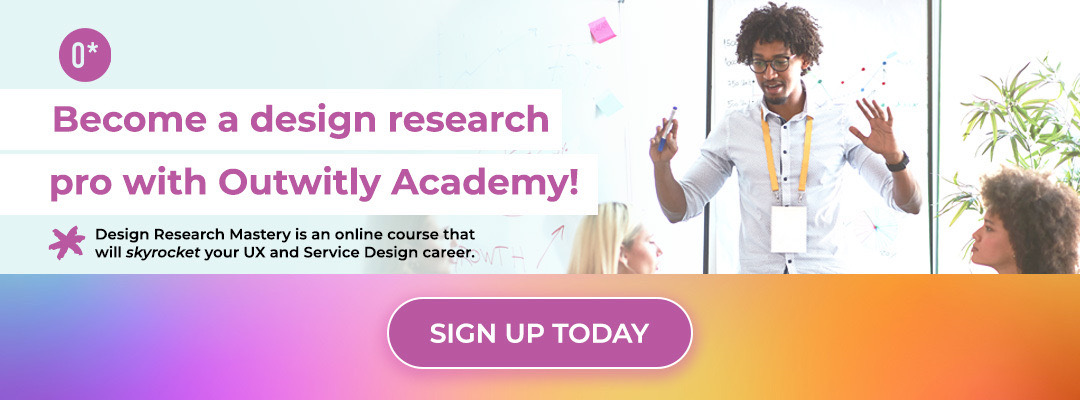
Author: Janine Loo
So, your time in academia is coming to a close, and you’re ready to bridge the gap to the real world of working in UX and service design. But how exactly do you take the skills you learned in school and translate them into a successful career?
What’s interesting about the design industry in particular is that so many designers come from different backgrounds: psychology, human–computer interaction, web design, business, engineering… the list is endless. This diversity is what makes our industry so unique. It’s cross-disciplinary, with professionals from many backgrounds coming into the industry all the time, and pushing to make design better. In fact, having a multi-disciplinary approach is a key pillar of human-centered design! Of course, with so many people coming out of non-design-related industries, the path into UX and service design work can be even less clear, and they may struggle to answer one big question: “How do I get a career in UX or service design?”
So much of what we do in design is dealing with messy and uncertain problems. But it can be hard to apply that way of thinking to something like your design career. This blog will help those who are ready to step into the design industry as a professional, and those who are still learning and wondering how to optimize their time as a student.
We’ll cover four ways to transition your academic skills to the design industry:
- Embrace the unknown and get to know yourself as a designer
- Collaborate and communicate
- Build a network
- Never stop learning
Embrace the unknown and get to know yourself as a designer
Looking for a job is difficult — it can feel vulnerable, and full of ambiguity. Well, we want to tell you to embrace this feeling. Lean into not knowing what comes next! The right solutions always come when you are willing to do the ambiguous and confusing stuff at the beginning. Here’s how:
-
- Explore your passions. We’ve all heard the proverb, “Choose a job you love and you will never work a day in your life.” While this expression might feel cliché, design is all about empathizing with people and truly wanting to understand their needs, so passion is a must. Think about what areas of design speak to you most, and reflect on what skills you will need to get there.
- Don’t be afraid to take classes that feel outside of your comfort zone. If you feel like you are a research master but are shaky when it comes to UI design, find classes that allow you to explore your weaker skills. Sometimes, you don’t realize you are passionate about something until you’ve given it a fair shot.
- Be thoughtful about the projects you choose. When given the freedom to choose the direction of your projects, be strategic. Your final fourth-year projects are going to be what you talk about in job interviews. So ask yourself, “Is this project going to get me a job? Will it be good for my portfolio? Is it aligned with the type of job I want to have?”
- Take advantage of short-term internships that are available to you as a student. If you’re still not sure what you want to do after graduation, then use your time as a student to try new things and figure out what resonates with you. Internships are amazing for allowing you to experience new areas without the pressure of an extensive commitment.
- Build a portfolio that reflects who you are. If you want to get interviews for job positions that excite you, then prepare projects that you love to talk about. A strong portfolio is an absolute must when applying for jobs in the design industry. Want more advice on how to build a stand-out portfolio? Keep an eye out for an upcoming Outwitly blog post on the topic!
The biggest asset you can have going into the professional industry is knowing yourself as a designer. By using school as a place to play and explore, you will have a stronger idea of what you like and dislike, what your strengths and weaknesses are, and what your professional goals are. This will make it easier for you to lean confidently into your passions when embarking on your new career.
Now, if you decide through this exploration that you’re interested in UX and service design, below are some further pointers you should consider that will help you build a successful career as a designer. We’ll start by addressing skills that are essential across the design industry as a whole, and finish with actionable ways to improve your marketability in UX and service design specifically.
Collaborate and communicate
Designers are inherently collaborative, and your success as a designer will depend on your ability to work with others. UX and service designers constantly work in cross-functional teams, from research, engineering and IT, to marketing, and product management. Consequently, we need to learn to communicate with our non-designer stakeholders in a way that resonates with them.
Here are a few ways to work on your collaboration and communication skills:
- Make the most of your peers. Ask their opinions, seek out feedback, and share your point of view. You’re surrounded by other creative individuals, and it’s not only a good idea to engage in collaboration, it’s necessary! Design doesn’t exist in a vacuum — strong design is intentional, with discussion and foresight going into every decision.
- Learn how to communicate with as many types of people as possible. It can be wonderful to have a consistent group of peers that you work with, but try to also work with new people! In industry, you won’t always be able to pick and choose who you’re working with, and it’s important to know how to navigate engaging with unfamiliar faces (it’s a good way to make new friends too!). The key to good UX and service design is having a good understanding of who you’re designing for, and knowing what questions to ask to gain that understanding, even when you don’t share their experiences.
- Talk about design with non-design people. In industry, you won’t communicate your results with a design professor who has given you a rubric with exact outcomes. Instead, you might not have any idea what the outcomes of your work are going to be, nor how to clearly communicate findings or insights. So, practice presenting your ideas without a rubric. Talk to people outside of your program about your work and your projects. Talk to people who don’t know anything about design, and convince them of why design work is important. See if you can gain people’s buy-in. You never know, this kind of engagement could also lead to something more down the road!
- Finetune your professional communication skills. Learning how to communicate professionally is crucial in UX and service design, especially when working with clients and stakeholders who may not have a design background. Clear and effective communication helps to ensure that everyone involved in a project is on the same page. It reduces the risk of misunderstandings and ensures that the end product meets the needs of the target audience. This includes mastering email etiquette, knowing how to give and receive constructive feedback, and being able to explain design concepts in a way that non-designers can understand (as mentioned above!).
- Work on developing your soft skills. In a previous blog post, we wrote about 10 must-have soft skills for UX designers. Never underestimate the importance of active listening, storytelling, facilitation and empathy, as you collaborate and communicate with others.
View this post on Instagram
Building a network
If you want to learn more about the design industry while you’re in school, talk to people in the design industry! Networking might not be something you think about when attending classes, but it does end up being important for getting jobs in the future. Many of your own classmates will one day be in positions to get you jobs, or become your clients. Always be kind and professional, because you never know who you’ll work with in the future. Here are some tips to start building your professional network:
- Your professors: They’ll teach you more than just the technical skills that you will need as a UX and service designer. They can help acquaint you with the industry, and how to navigate being a professional. They have a wealth of knowledge and experience, so building relationships with them is crucial. Not only can they give you professional insights, but they can also be key to landing internships and full-time jobs.
- Senior students: These are individuals who might be closer to you in experience and could have a better pulse on what it’s like to apply for internships and jobs as a student. They may also have insights into what skills and attributes the industry is looking for currently. Make an effort to talk with students outside of your cohort, and don’t shy away from working with them on projects.
- Guest lecturers: You will have access to incredible speakers while you’re in school — individuals who would normally not be available to have their brains picked. Ask questions and spark conversation when you have guest speakers. Many students won’t take a chance and put themselves out there, so engaging with guests can make you especially memorable.
- Networking events: There are plenty of in-person or virtual networking events available to UX and SD, and the community is tight. We suggest the Service Design Network as a great place to start participating.
- Mentors and mentorship platforms: Building a professional relationship with a mentor is an amazing way to get personal feedback and help you develop your career. We recommend being intentional about who you ask to be your mentor. Asking busy people at random is not the best way to start a professional relationship. Instead, go to places where senior industry professionals have actively decided to become mentors! Some of our top recommendations would be UX Coffee Hours, ADPList, Re: Create, Design Lab and Growth Mentor.
- Alumni groups: Many incredible groups connect former students of UX and service design-related educational programs in Canada. Get involved with one!
Never stop learning
The world of design moves quickly, and there are always new skills and techniques to learn. Even when you step out of the world of academia into industry, it’s so important to continuously learn in order to be successful. Keeping yourself updated on design literature, going to conferences, and even just talking to your fellow designers are all great ways to keep you fresh and knowledgeable. You also don’t need to overcomplicate it — there’s plenty of valuable (and free!) education available. Visit your local library or throw on an episode of a UX/service design podcast!
MDes Programs
Many of the service designers working at Outwitly have post-graduate degrees. Getting a master’s degree will help you develop well-rounded design skills that translate seamlessly into your future career path! Your professors will guide you through deep learning on critical aspects of design, and your cohorts will share their life experiences and unique perspectives, which enable you to think even deeper about design. You can finish your program with a new group of people who can help you find the right opportunities, as well as a lot of relevant experiences to help you land those opportunities: portfolio projects, ways of articulating what you offer, new skills, and more. The UX and service design job hunt can be competitive, especially if you dream of working for top companies and organizations doing big, exciting things. A master’s certainly gives you that extra edge on your resume.
If you’re interested in pursuing advanced education, check out the MDes programs offered at Canadian post-secondary institutions like OCAD (Ontario College of Art and Design), Carleton University, Emily Carr University, York University, the University of Alberta, and more. We’d also like to notably mention the MDEI (The Master of Digital Experience Innovation) program at the University of Waterloo!
Join Outwitly Academy
If you’re looking to take your UX design and research skills to the next level, make sure to enroll in Outwitly Academy’s flagship course, Design Research Mastery, created by Outwitly’s founder, Sara Fortier! As a university-level instructor and an employer of designers entering the field, she’s found that students don’t always learn a lot of tangible and practical skills to apply UX and service design practices in the real world. She was inspired to remedy this with a specially crafted course.
Through Design Research Mastery (DRM), designers get to learn hands-on processes that aren’t taught in school, through engaging, flexible and easy-to-follow online lessons. Not only is DRM helpful for new designers, but also for the many people transitioning into service design or UX research careers from other backgrounds!
Design Research Mastery is the blueprint for running effective UX and design research projects in the REAL WORLD. This course teaches you the ins and outs of scoping, planning, recruiting, conducting, analyzing and reporting on user research. It’s perfect for anyone wanting to hone their skills, establish a better design/research practice, or transition into service design.
Explore FREE Content from Outwitly
Did you know that we create free ebooks, mini courses, and webinars for designers and researchers? If you’re just getting started in UX and service design, these downloadables and courses have a ton of practical and tangible tips to get you started and help you along the way. Explore them below!
- Plan a Stellar User Interview Workbook
- Month of Free UX and Service Design Guides
- Recruiting Users for Research: A 5-day email video course
- Empathy Mapping Downloadable
- UX Maturity Downloadable
- Guide to Customer Journey Maps vs. Service Blueprints
P.S. Don’t miss out on the announcement of new freebies! Stay in the know by subscribing to our weekly newsletter and following us on Instagram.
We hope this post helped provide sound advice and tangible, actionable steps you can take to bridge the gap between academia and entering the working world of UX and service design.




